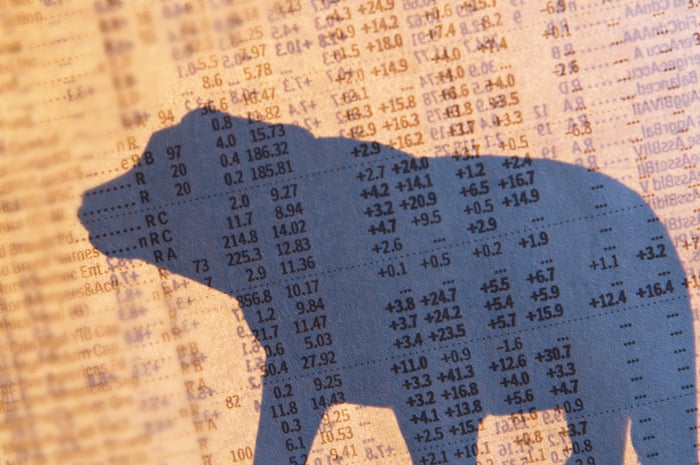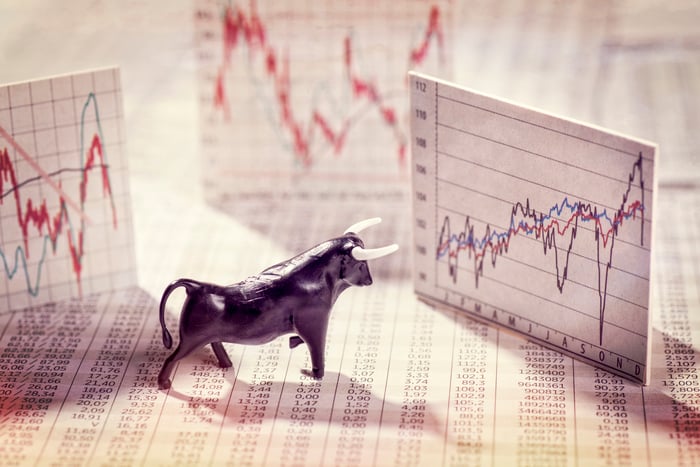The stock market has been anything but predictable since the start of 2020. Investors have navigated their way through the quickest bear market decline in history early in the COVID-19 pandemic, yet another bear market in 2022, and two periods where stocks have outperformed (2021 and the first half of 2023).
What happens next to the iconic Dow Jones Industrial Average (^DJI 0.77%), benchmark S&P 500 (^GSPC 0.83%), and growth-focused Nasdaq Composite (^IXIC 1.02%), is anyone's best guess... or is it?
Although there's no specific predictive tool that can call directional movements in the stock market with 100% accuracy, there are a handful of indicators and data points with phenomenally strong track records of doing so. One of these forecasting tools hasn't been wrong in more than a half-century, and it offers a very clear picture of what's expected to happen next to stocks.

Image source: Getty Images.
This forecasting tool has been flawless since 1966
For much of the past year, I've examined no shortage of data points that offer their take on what's next for the stock market. However, few of these forecasting tools have the track record offered by the Federal Reserve Bank of New York's recession probability tool.
The premise of the New York Fed's recession probability indicator is simple: it examines the difference in yield (known as "spread") between the 10-year U.S. Treasury bond and three-month bill to determine how likely it is that a U.S. recession will take place within the next 12 months.
Normally, the Treasury yield curve slopes up and to the right. This is to say that longer-maturing bonds (those set to mature in 10 or 30 years) will offer higher yields than bills set to mature in a matter of months, or perhaps a year from now. The longer your money is tied up, the greater the opportunity cost -- ergo, the higher the yield you should be rewarded with.
But when investors are clearly worried about the outlook for the U.S. economy, the Treasury yield curve can invert. This is when short-term bills bear higher yields than long-term Treasury bonds. Although not every yield-curve inversion has been followed by a recession, all 12 U.S. recessions after World War II have been preceded by a yield-curve inversion.
10 Year-3 Month Treasury Yield Spread data by YCharts. Gray areas denote U.S. recessions.
Earlier this week, the New York Fed updated its recession probability tool with data from August. While it represented the third consecutive month that the inversion between the 10-year note and three-year bill lessened, the probability of a U.S. recession through August 2024 still stands at 60.83%. The last four months of readings have all represented the highest probability of a U.S. recession since 1981-1982.
To be fair, the New York Fed's predictive recession tool has been wrong before -- but it's been a while. In October 1966, the probability of a U.S. recession within 12 months surpassed 40%, but no recession ever materialized. In the roughly 57 years since this incorrect forecast, any time the New York Fed's predictive tool has surpassed a 32% probability of a recession, one has eventually followed.
Though the U.S. economy and stock market aren't tied at the hip, a recession typically results in a decline in corporate earnings. This would mean an already pricey stock market could push even more into nosebleed territory.
More importantly, the Dow, S&P 500, and Nasdaq Composite, have historically performed poorly following the official declaration of a recession. Approximately two-thirds of the S&P 500's drawdowns following World War II have occurred after, not prior to, a recession being declared.
Long story short, the New York Fed's recession probability tool would suggest stocks are going to move lower as economic weakness takes hold in the months and quarters that lie ahead.

Image source: Getty Images.
Meanwhile, this trend has been a winner for investors for over 100 years
Admittedly, the New York Fed's probability indicator doesn't provide the rosiest outlook for Wall Street. Then again, if investors widen their time horizon beyond a couple of quarters, or even a few years, things brighten up considerably.
As much as investors might fear stock market corrections, bear markets, and economic downturns, they're all perfectly normal and inevitable events.
But did you know that only three of the 12 recessions following World War II have lasted longer than one year, with none surpassing 18 months? While perfectly normal, U.S. recessions are, historically, short-lived. By comparison, almost every economic expansion since World War II ended has lasted multiple years, if not a full decade. In other words, the U.S. economy spends far more time expanding than it does contracting.
This same variance between optimism and pessimism can be seen on Wall Street. According to comprehensive data from wealth management company Bespoke Investment Group, the 27 bear markets the S&P 500 has endured since September 1929 have lasted an average of 286 calendar days (about 9.5 months). That compares to 27 bull markets that have lasted an average of 1,011 calendar days for the S&P 500 over the same 94-year timeline.
The most important element to generating positive returns on Wall Street is time. Analysts at Crestmont Research examined what an investor would have generated in total returns, including dividends, if they, hypothetically, purchased the S&P 500 and held for 20 years. Using back-tested methods, Crestmont was able to gather total returns data for 104 rolling 20-year periods (1919-2022) dating back to 1900.
What researchers found was that all 104 rolling 20-year periods produced positive total returns. In fact, more than 50 of these rolling 20-year periods resulted in annualized total returns ranging from 9% to as high as 17.1%. Not only has time handsomely rewarded patient investors for more than a century, but in many instances, it's helped them crush the prevailing rate of inflation and generate real-money returns.
Regardless of whether or not the New York Fed's forecasting tool is correct, long-term investors have little to worry about.






